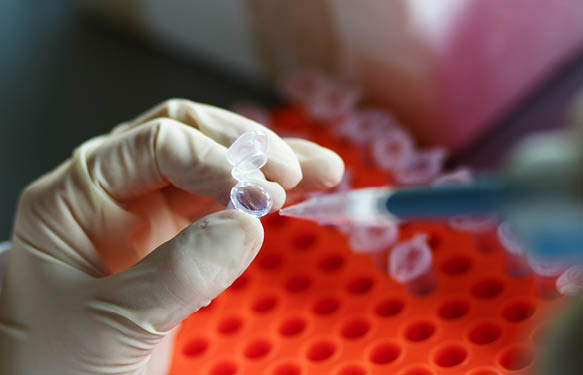Adenoassociated viruses (AAV) are small (20-30 nm), ssDNA, non-enveloped and replication-defective viruses that infect human and other primate species, but which, up to now, have not been reported as being the cause any known disease. They can infect both dividing and quiescent cells.
When they occasionally do so, AAV always integrate in one non-mutagenic unique location (on Chromosome 19). Most AAV used for gene delivery are modified to force integration and are thus suitable for long-term studies. They do not ellicit strong immune responses owing to the removal of their VP2 capside protein by genetic engineering.
These features makes them excellent Gene therapy tools.
Nine AAV serotypes have been identified, each showing a tropism for specific tissues or cell types. This is a paramount advantage when it comes to transducing one cell type from a tissue usually comprised of multiple cell types. Hybrid AAV with AAV2 genome and different combinations of capside proteins that give serotype specificity are classically used for gene delivery.
The extraordinary diffusion capacity of AAV in toto (owing to their small size) makes them the best choice for tissues with small intercellular spaces (such as tumors, embryo, brain regions, muscle, kidney…) over lentiviral and adenoviral particles (with larger size, 100 nm).
On top of their advantages for gene delivery, being ssDNA, AAV lead to faster protein expression than lentiviral particles (no need for retrotranscription before integration).
AAV are easy to use and safe… but they also have some drawbacks: they are only able to accommodate inserts shorter than 4.5 kb and they remain difficult to produce (even if some new technologies have been developed from modified cell lines that allow the mass production of AAV particles).
As mentioned above, AAV serotypes show certain tissue specificity:
- AAV1: neurons, retina, heart, lung, skeletal muscle, vascular endothelial cells
- AAV2: neurons, retina, hepatocytes, cardiomyocytes, lung, kidney
- AAV5: astrocytes, lung, vascular endothelial cells, photoreceptor cells,
- AAV7: hepatocytes, murine skeletal muscle cells
- AAV8: adipocytes, neurons, liver, skeletal muscle, pancreas
- AAV9: adipocytes, neurons, cardiomyocites, hepatocytes, lung, skeletal muscle
If you’re interested in using AAV in vitro or in vivo or if you want to know more about this topic, I’ll be pleased to answer any of your questions… just leave your comments below!




2 responses
If I want to delivery a gene in vivo, and I hope this gene can be ubiquitously expressed, which delivery system should i choose? Thanks!
Hi Andrew, thank you very much for your comment. First the term ubiquous should be defined…do you want 100% of cells expressing the gene? There are viral systems that are “pan-infective” but these systems will infect a little percentage of most lineages of the organism. If you want to have your gene expressed in all cells, the best option is always embryo manipulation (oocyte microinjection or ES cell knock-in (CRISPR or homologous recombination)…).
For ubiquous expression of a protein by infection in only a small percentage of cells, I would recommend the use of lentiviral or retroviral systems (as they not show any tropism, they infect all cells lineages). If you want higher “permeability” of the infection, AAV are more recommended (because they are smaller than lentiviruses or retroviruses) and I would recommend a combination of serotypes (AAV2, AAV5, AAV7) to conjugate tropisms of all AAV serotypes.